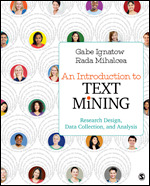An Introduction to Text Mining
Research Design, Data Collection, and Analysis
- Gabe Ignatow - University of North Texas, USA
- Rada Mihalcea - University of Michigan, USA
“In the age of big data, this text is an excellent introduction to text mining for undergraduates and beginning graduate students. The proliferation of text as data particularly in social media require the inclusion of this topic in the data analysis toolkit of the social scientist.”
–A. Victor Ferreros, Florida State University
“This is an excellent book that covers a broad range of topics on text analysis. Examples from a variety of disciplines are used, making the text useful to students across the social sciences, humanities, and sciences and also accessible to those who do not have a deep background in this area.”
–Jennifer Bachner, Johns Hopkins University
Teach students how to construct a viable research project based on online sources.
Gabe Ignatow and Rada Mihalcea's An Introduction to Text Mining provides a foundation for readers seeking a solid introduction to mining text data. The book covers the most critical issues that must be taken into consideration for research projects, including web scraping and crawling, strategic data selection, data sampling, use of specific text analysis methods, and report writing. In addition to covering technical aspects of various approaches to contemporary text mining and analysis, the book covers ethical and philosophical dimensions of text-based research and social science research design.
Instructors, sign into study.sagepub.com/ignatow for additional resources!
Supplements
Password-protected Instructor Resources include:
- Editable, chapter-specific Microsoft® PowerPoint® slides that offer you complete flexibility in easily creating a multimedia presentation for your course.
- Author-written assignments and activities, including accompanying data sets, can be used as in-class exercises, homework assignments, or exam questions.
The open-access Student Study Site includes downloadable data sets selected by the authors for use with assignments and activities.
“This is a comprehensive book on a timely and important research method for social scientific research. Researchers who want to learn the development of text mining methods and learn how to integrate the methods into their research projects will find this book beneficial.”
“In the age of big data, this text is an excellent introduction to text mining for undergraduates and beginning graduate students. The proliferation of text as data particularly in social media require the inclusion of this topic in the data analysis toolkit of the social scientist.”
“This is an excellent book that covers a broad range of topics on text analysis. Examples from a variety of disciplines are used, making the text useful to students across the social sciences, humanities, and sciences and also accessible to those who do not have a deep background in this area.”
“This book provides an excellent base for budding data scientists and provides tools, methods and references that will be extremely useful in their work. Methods from various disciplines are discussed in detail and provide a wonderful base for building business appropriate data mining projects.”
I was looking for a book in Text Mining geared towards undergraduates in computer science. This book does have several chapters that would be geared towards comp sci students, but it's not sufficient. However, the book would be more useful for the humanities to get an understanding of how to apply text mining along with a research-focused approach of the book, while learning some useful methods from computer science.
Sample Materials & Chapters
Chapter 1: Text Mining and Text Analysis
Chapter 6: Web Scraping and Crawling

